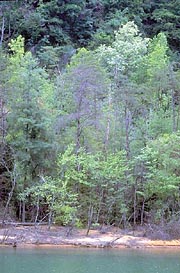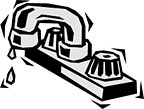
Seeing the Forest for the Trees
A recent study conducted by World Wildlife Fund (WWF) and The World Bank reveals that protected forests can be a cost-effective means to purify and provide quality drinking to major cities. Instead of spending billions on water treatment facilities, urban centers should focus their dollars and their efforts on conserving forested areas, the report “Running Pure” suggests.The report establishes that more than a third of the world's 105 biggest cities - including New York, Tokyo, Los Angeles, Nairobi and Melbourne - get much of their drinking water supply from protected forests. These forests, which reduce landslides, erosion and sedimentation, improve water quality by filtering pollutants like pesticides; in some cases, they even capture and store water.
Rather than create costly water treatment plants, the report asserts, an economical alternative for these cities would be to adopt forest protection strategies.
For example, building a new water treatment plant for New York would run an estimated $6-$8 billion in startup costs and $300-$500 million in annual operating costs, whereas protecting land and forest resources would cost an estimated at $1-$1.5 billion over 10 years.
The nine million residents of New York and surrounding areas receive their drinking water supply mostly from the Catskill, Delaware and Croton watersheds. Together, these watersheds deliver 1.3 billion gallons of water daily to the New York City metropolitan area, and forests constitute 75 percent of the land area in these watersheds.
The report emphasizes, however, that as forests are being depleted globally at a rate of 28 hectares per minute, the time to take action is now.
“For many cities, time is running out. Protecting forests around water catchment areas is no longer a luxury but a necessity,” states David Cassells, environmental specialist at The World Bank. “When the forests are gone, the costs of providing clean and safe drinking water to urban areas will increase dramatically.”
For further information regarding forest conservation and its effects on improving the global water supply, read the WWF/World Bank report “Running Pure: the importance of forest protected areas to drinking water” at www.forest-alliance.org.

Water Conservation Tips
With increasing environmental concerns regarding water use and its future availability, especially in drought-plagued areas of the country, many are doing what they can to modify their water consumption.Consider this: The average person each day uses about 62 gallons of water, with the majority of water used for clothes washing, toilet flushing and showering, followed by faucet use and leaky fixtures. Such usage can take its toll - on private water supplies, in particular.
If your clients are interested in conserving water at home, following are some suggestions on ways to conserve water with some minor household adjustments.
- Replace an old toilet with a new 1.6 gallon-per-flush model. This measure can save a typical household from 7,900 to 21,700 gallons of water per year;
- Save more than 1,000 gallons per year by placing a plastic jug of water or commercial “dam” in older toilet tanks to cut down on the amount of water needed for each flush;
- Repair dripping faucets and leaking toilets (flapper valves usually are the cause). Repairs can save more than 10 gallons of water per person per day. A faucet dripping at one drop per second wastes 2,700 gallons per year;
- Wash clothes and dishes only when you have a full load. When replacing an older machine, consider high efficiency models, which use an average of 30 percent less water and 40 percent to 50 percent less energy, saving about nine gallons per washing machine cycle and 7.5 gallons per dishwasher cycle;
- Install low-flow, water-efficient showerheads and faucets and save 1 gallon to 7.5 gallons per minute. Taking a quick shower can save an average of 20 gallons of water; and turn off the water when brushing teeth or shaving to save more than 5 gallons per day.
The tips suggested here are provided courtesy of the Pennsylvania Department of Environmental Protection.
Report Abusive Comment